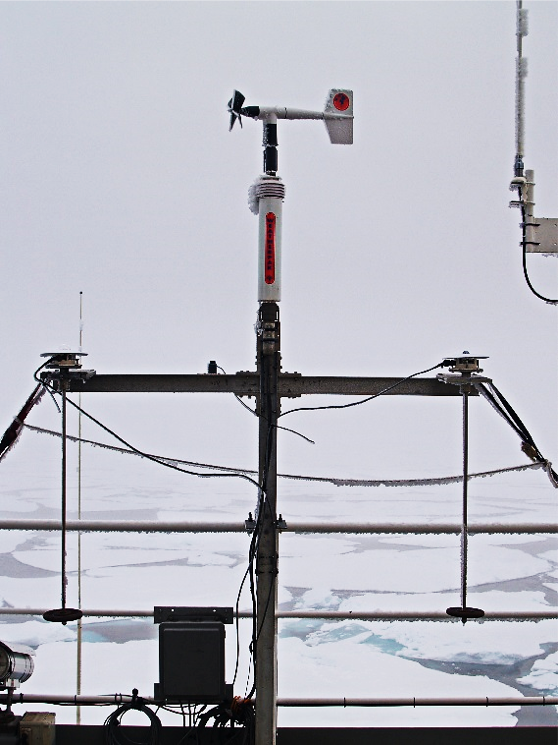Michael Tjernström
The WeatherPak station is an integrated unit mounted approximately mid-ship on the forward railing on the Icebreaker Oden's 7th deck about 27 m above sea level, on top of the bridge. Measured variables include wind speed and direction, temperature, relative humidity, pressure, and solar and ultraviolet radiation. Winds are given both relative to the ship and as “true winds”. Note that relative winds from the aft (relative wind direction from approximately 90° to 270°) are in the wake of the ship's main mast. Care should always be used when measuring on a ship, especially for wind that more than likely is affected by the flow distortion around the ship. Wind, temperature and relative humidity data was cross-checked with Oden's permanent weather station and agree as well as can be expected for two different locations on a ship.
Download data
Visit web site
Citation
Michael Tjernström (2018) Weather data from WeatherPak station from the high-Arctic ASCOS expedition 2008. Dataset version 1. Bolin Centre Database. https://doi.org/10.17043/oden-ascos-2008-weatherpak-1
References
Tjernström, M. et al. 2014. The Arctic Summer Cloud Ocean Study (ASCOS): overview and experimental design. Atmospheric Chemistry and Physics, 14, 2823–2869. https://doi.org/10.5194/acp-14-2823-2014
Data description
An additional weather station was mounted on the front railing of Oden's 7th deck. Variables measured include wind speed and direction, temperature, relative humidity, pressure, and solar and UV radiation. There is also a longwave radiometer, but that seems to have some problems and is not included. The wind, temperature and RH data has been cross-checked with the Oden weather station and seems to agree as well as can be expected for two different locations on a ship. The wind speeds are systematically lower than for the Oden weather station by some 30% and both the wind speed and direction shows some wake structure from being in front of Oden's superstructure and tower. The WeatherPak temperature is about 1 °C warmer than the weather station, the RH has poor correlation and the shortwave radiation is low compared to MetAlley observations in the 75-125 W/m2 range and somewhat high above 250 W/m2. The data in the zip-file include a matlab and and an ascii file.
Comments
ASCOS carried two weather stations: Oden's own weather station and an additional weather station, here referred to as “WeatherPak”. Both were located mostly on Oden's 7th deck about 27 m above sea level, on top of the bridge.
Sensors for the Oden weather station were distributed over the 7th deck (temperature, humidity and visibility), on the bridge (pressure) and in the top mast of Oden (2D sonic anemometers for wind speed and direction). In addition to these basic meteorology observations, this data file also contains ships navigation information (position, speed, course and heading). Wind information is provided both relative to the ship (w/ direction 360° for winds on the bow) and corrected “true” winds, taking Oden's movement into account.
The WeatherPak station is an integrated unit mounted approximately mid-ship on the forward railing on the 7th deck. Variables measured include wind speed and direction, temperature, relative humidity, pressure, and solar and UV radiation. Also here, winds are given both relative to the ship and as “true winds”. Note that winds from the aft (relative wind direction from approximately 90° to 270° are in the wake of the ship's main mast.
Care should always be used when measuring on a ship, especially for wind that more than likely is affected by the flow distortion around the ship. Temperature may show a slight warm bias, especially when the real temperature is low due to heat from the superstructure.
Wind, temperature and RH data was cross-checked between the two weather stations and agrees as well as can be expected for two different locations on a ship. WeatherPak wind speeds are systematically lower than for the Oden weather station, by some 30%. It is likely that the Oden wind speeds are higher than reality, because of a Venturi-effect from the ships superstructure, while the WeatherPak wind speed may be low because of the wake from the superstructure. The WeatherPak temperature is consistently about 1 °C warmer than the weather station, which is likely a calibration problem, the RH has poor correlation and the shortwave radiation is slightly low in the 75-125 Wm-2 range and somewhat too high above 250 Wm-2.
Original address: http://www.ascos.se/index.php?q=node/315
Files:
WeatherPak.zip (5.37 MB)
Image caption
Photo of the WeatherPak integrated weather station attached to the railing on 7th deck. All sensors are integrated into the central column, except the radiation sensors on each side, mounted on gimballed platforms.
